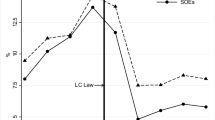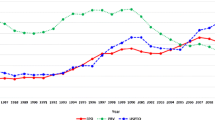Abstract
Little is known about the impact of intellectual property rights (IPRs) on typically imitative self-employment. IPR laws have contrasting dual innovation creation and access effects on self-employment activity. The first effect is positive where strong IPR laws promote innovation and so create new opportunities for self-employment. The second effect is negative where strong IPR laws restrict access to innovation and technology used as inputs to self-employed businesses. Using a 33-country dataset over the period 1995–2000, we estimate the impact of IPR laws on self-employment, helping to fill the vacuum of empirical evidence that has plagued policy decision making in this area. We find that patent activity has a negative effect on self-employment. However, overall, we find that more extensive and strong IPR laws have a net positive effect on self-employment activity.
Similar content being viewed by others
Notes
See Martin (2002) for an overview.
The cross-derivatives ∂I/∂IP and ∂IP/∂I would be expected to be positive when innovation and external IP are complements and negative when they are substitutes.
It is customary to assume that the elements of the profit function are multiplicative so that ∂Y/∂I is positively related to the level of capital and labour in the business. This implies that returns from investing in innovation are less for small-scale firms that use less labour and capital. In addition, if firms face financial constraints then they may not have sufficient financial resources to invest in innovation.
These classifications are based on the following per capita income groups defined by the World Bank: low income, US$975 or less; lower middle income, $976–$3,855; upper middle income, $3,856–$11,905; and high income, $11,906 or more.
The only country in our sample to join Berne after the start of our sample period (1995) is Singapore which joined the treaty in 1998.
We also note that Burke et al. (2008) find a negative relationship between unemployment and persistence in self-employment.
Establishing a company in this context may be necessary to facilitate raising finance from business angels and venture capitalists. It also has the attraction of limiting the liability of the entrepreneur, to the amount they have invested in the business, in what may be a high risk venture.
The natural log transformation is used in the analysis since the self-employment rate is a non-negative random variable. Accordingly, the support of ln (S) is the entire real line meaning that no restrictions are required on the support of the disturbance term in estimating the model.
The idea underlying this test is that, if cov(x it , u i ) = 0, the estimates obtained from the fixed and random effects models, respectively, should not differ systematically since both estimators are consistent. In contrast, if cov(x it , u i ) ≠ 0, then the estimates will differ systematically (only the fixed effects estimator is consistent in that case) and the inference is that the random effects model is mis-specified.
The self-employment data, in fact, cover a longer time span. However, the estimation sample is constrained by the span of patent registrations data (1995–2000). We estimated models, with longer sample periods, by omitting the patents data, but these models failed the mis-specification tests.
A referee made the valid point that these are luxury goods the consumption of which may be expected to be (positively) correlated with wages. Therefore, these goods could pick up some of the opportunity cost effects of wages on self-employment. To test this idea, we therefore looked at the sample correlations between the IPR/luxury goods and wages. However, with the exception of cable TV (ρ = −0.253; p value = 0.019), these correlations were statistically insignificant; also, the sign of the correlation in the case of cable TV is the opposite of what would be expected if the variable was measuring part of the wage effect. This gives us some confidence that the effects being picked up by the IPR-related goods are not related to the opportunity cost of wages.
i.e., 100(e0.134 − 1) and 100(e−0.274 − 1), respectively.
Many republics arose from the over-throw of a monarchy or totalitarian regime (e.g., France, Germany, Italy and Romania) or as a result of the country gaining independence from a colonial ruler (e.g., US, Iceland, Ireland and Singapore). These political conditions may provide fertile ground for a heightened desire for independence across the population which, in one sense, could be expressed through a higher incidence of self-employment.
i.e., exp[1.935/(2 × 0.107)].
References
Acs, Z., & Audretsch, D. (1990). Innovation and small firms. Cambridge, MA: MIT Press.
Almeida, P., & Kogut, B. (1997). The exploration of technological diversity and the geographic localization of innovation. Small Business Economics, 9, 21–31.
Arrow, K. J. (1962). Economic welfare and the allocation of resources to invention. In R. R. Nelson (Ed.), The rate and direction of inventive activity. Princeton: University Press.
Audretsch, D. B. (1995). Innovation and industry evolution. Cambridge, MA: MIT Press.
Audretsch, D., & Thurik, R. (2004). A model of the entrepreneurial economy. International Journal of Entrepreneurship Education, 2(2), 143–166.
Baumol, W. J. (1990). Entrepreneurship: Productive, unproductive and destructive. Journal of Political Economy, 98(5), 893–921.
Besen, S. M., & Raskind, L. J. (1991). An introduction to the law and economics of intellectual property. Journal of Economic Perspectives, 5, 3–27.
Bhide (2000). The origin and evolution of new business. Oxford: Oxford University Press.
Bhide (2008). The venturesome economy. Princeton: Princeton University Press.
Blanchflower, D., & Oswald, A. (1998). What makes an entrepreneur? Journal of Labor Economics, 1998(16), 26–60.
Block, J., & Koellinger, P. (2009). I can’t get no satisfaction—necessity entrepreneurship and procedural utility. Kyklos, 62(2), 191–209.
Bound, J. C., Cummins, C., Griliches, Z., Hall, B. H., & Jaffe, A. (1984). Who does R&D and who patents. In Z. Griliches (Ed.), R&D, patents and productivity. Chicago: Chicago University Press.
Burke, A. E., FitzRoy, F., & Nolan, M. (2000). When less is more: Distinguishing between entrepreneurial choice and performance. Oxford Bulletin of Economic and Statistics, 62(5), 565–587.
Burke, A. E., FitzRoy, F. R., & Nolan, M. A. (2008). What makes a die-hard entrepreneur? Beyond the ‘employee or entrepreneur’ dichotomy. Small Business Economics, 31(2), 93–217.
Cornish, W. R. (2003). Intellectual property: Patents, copyright, trade marks and allied rights (5th ed.). London: Sweet & Maxwell.
Evans, D., & Jovanovic, B. (1989). An estimated model of entrepreneurial choice under liquidity constraints. Journal of Political Economy, 97(4), 519–535.
Foreman-Peck, J. S. (1985). Seedcorn or Chaff? New firm performance in the interwar economy. Economic History Review, 38(3), 402–422.
Hamilton, B. H. (2000). Does entrepreneurship pay? An empirical analysis of the returns to self-employment. Journal of Political Economy, 108(3), 604–631.
Johnson, P. (2007). The economics of small firms. London: Routledge.
Kihlstrom, R. E., & Laffont, J.-J. (1979). A general equilibrium theory of firm formation based on risk aversion. Journal of Political Economy, 87(4), 719–748.
Landes, W. M. (2003). Copyright. In T. Ruth (Ed.), A handbook of cultural economics. Cheltenham: Edward Elgar.
Lanjouw, J. O., & Schankerman, M. (2004). Protecting intellectual property rights: Are small firms handicapped? The Journal of law and Economics, 47(1), 45–74.
Martin, S. (2002). Advanced industrial economics (2nd ed.). Oxford: Blackwell.
Parker, S. (2004). The economics of self-employment and entrepreneurship. Cambridge: Cambridge University Press.
Schmitz, J. A. (1989). Imitation, entrepreneurship and long-run growth. Journal of Political Economy, 97, 721–739.
Schultz, T. W. (1975). The value of the ability to deal with disequilibria. Journal of Economic Literature, 13, 827–846.
Schultz, T. W. (1980). Investment in entrepreneurial ability. Scandinavian Journal of Economics, 82(4), 437–448.
Storey, D. (1994). Understanding the small business sector. London: Routledge.
Author information
Authors and Affiliations
Corresponding author
Rights and permissions
About this article
Cite this article
Burke, A., Fraser, S. Self-employment: the role of intellectual property right laws. Small Bus Econ 39, 819–833 (2012). https://doi.org/10.1007/s11187-011-9336-5
Accepted:
Published:
Issue Date:
DOI: https://doi.org/10.1007/s11187-011-9336-5




